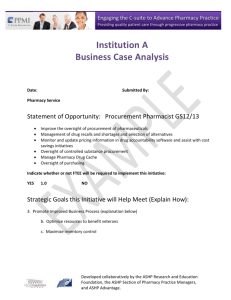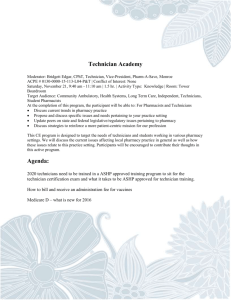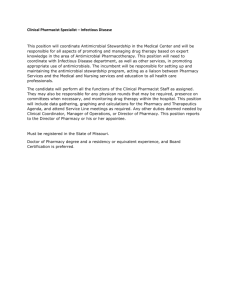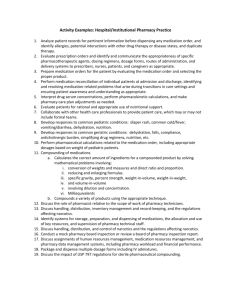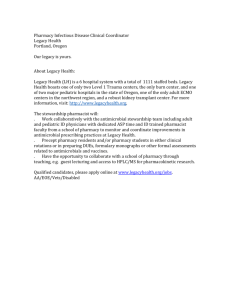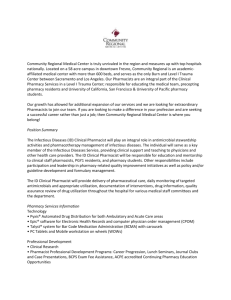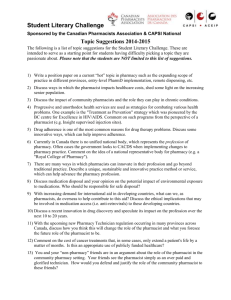Business Case - Pediatric Operational FTE
advertisement
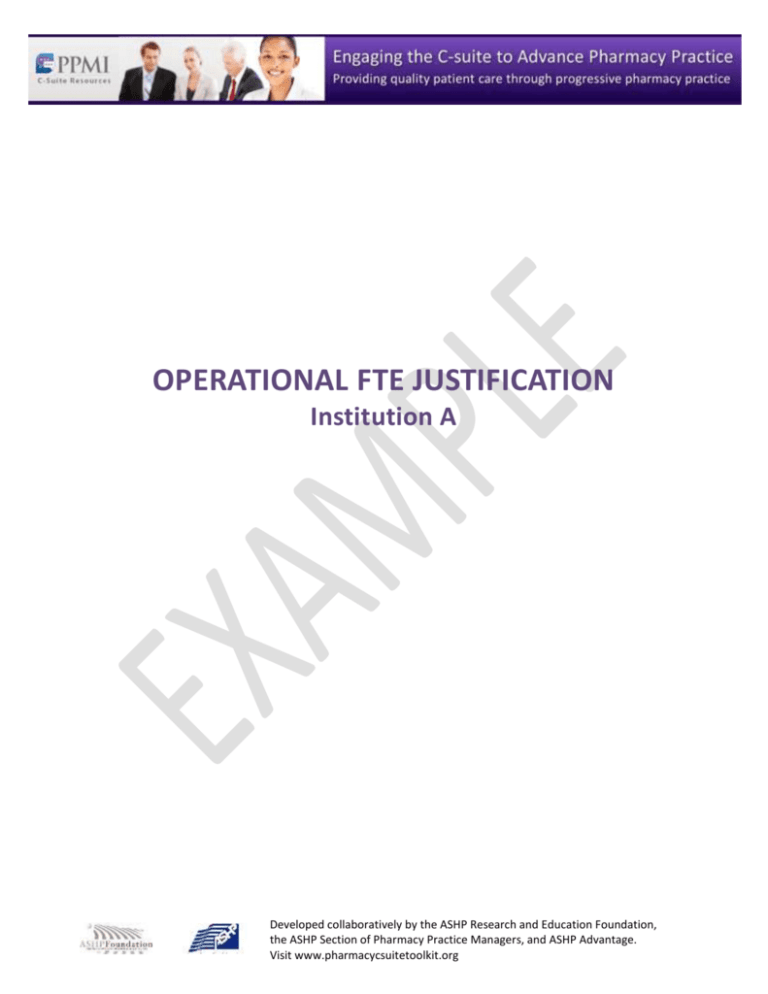
OPERATIONAL FTE JUSTIFICATION Institution A Developed collaboratively by the ASHP Research and Education Foundation, the ASHP Section of Pharmacy Practice Managers, and ASHP Advantage. Visit www.pharmacycsuitetoolkit.org 1 TABLE OF CONTENTS I. Executive Summary Page 3 II. Introduction Page 3-4 III. Summary of Request Page 5 IV. Data Analysis Page 5-9 V. Operational Impact Page 9 VI. Financial Analysis Page 10 VII. Timeline Page 10 VIII. References Page 10-11 Developed collaboratively by the ASHP Research and Education Foundation, the ASHP Section of Pharmacy Practice Managers, and ASHP Advantage. Visit www.pharmacycsuitetoolkit.org 2 I. EXECUTIVE SUMMARY Clinical pharmacists have consistently been utilized in inpatient settings to improve patient outcomes while decreasing costs of treatment. Pediatrics has been identified as a high risk group due to highly individualized regimens based on age and weight-based dosing. Numerous studies have demonstrated significant therapeutic and financial benefit from the addition of a clinical pharmacist to the healthcare team. Currently at Institution B, the pediatric and adult cardiac intensive care units, located at Institution A and Institution C share a clinical specialist. Due to the increase in patient volume and physical separation across campus of the two units, the current pharmacist cannot provide adequate coverage to both teams and will transition to the adult cardiac unit full time. In order to continue to offer pharmacy coverage to the pediatric cardiac intensive care unit, an additional clinical pharmacist is required. A full time replacement is requested, which will allow continuation of the current services with additional opportunity to expand pharmacy services offered in the Institution A. Cost savings data in pediatric intensive care units have supported the employment of a clinical specialist. Cost of errors avoided, optimization of therapy, decrease in annual drug costs, and addition of new covered services result in substantial cost avoidance. Not having an additional pharmacist will result in reduced or lack of coverage in a high acuity area. Based on a published meta-analysis of a pharmacoeconomic benefit:cost ratio, this position will save Institution A an estimated $633,600.i Additionally, the expansion of pharmacy coverage will not be possible. This proposal is highly supported by the Institution A Administrative and Clinical Service Line Leaders. II. INTRODUCTION Since the Joint Commission Sentinel Event Alert addressing pediatric medication errors was published, research has focused on improving the quality of care in this specialized population. The American Academy of Pediatrics (AAP) issued a policy statement on prevention of inpatient medication errors in 2003.ii AAP cited pediatric medication error rates as high as 1 in every 6.4 orders, which were significantly higher than adult rates. Children are more susceptible to serious consequences from medication errors as a result of immature organ systems with less capability to buffer errors. In addition, unique challenges are also present in the pediatric population, including weight-based dosing, age-specific dose ranges, off-label medication use without accepted doses, and lack of standardized dilution practices. Developed collaboratively by the ASHP Research and Education Foundation, the ASHP Section of Pharmacy Practice Managers, and ASHP Advantage. Visit www.pharmacycsuitetoolkit.org 3 In 1992, a report published by the US Poison Control Center found that cardiovascular drugs, when compared to many other drugs, led to higher fatality events in children.iii Among the multiple cardiac drugs represented, antiarrhythmics, antihypertensives, cardiac glycosides, and nitroprusside were implicated in pediatric fatalities. Furthermore, according to a US Pharmacopeia MEDMARX database query for cardiovascular medication error reports in pediatric inpatients from 2003-2004, the drugs implicated in harmful drug errors include calcium channel blockers, phosphodiesterase inhibitors, antiarrhythmics, and digoxin.iv Incorrect drug dose was cited as the most commonly observed error in the study. Additionally, the Institute for Safe Medication Practices 2008 List of High Alert Medications includes numerous drugs commonly utilized in PCU including the aforementioned medications in addition to concentrated electrolytes, opioids, and sedating agents. As a result of the high rate and serious consequences of medication errors, pharmacists’ involvement in pharmacotherapy is consistently being researched. Numerous studies have shown that involving a clinical pharmacist in therapeutic decisions significantly decreases error rates. A study evaluating thromboembolism and infarction-related events found that adult ICUs without a designated clinical pharmacist had a 37% higher mortality rate, 14.8% longer length of stay, and approximately $1,700 higher Medicare and drug charges per patient.v Utilization of a clinical pharmacist in the pediatric intensive care unit has also resulted in a decreased cost of care, decrease in medication errors, and optimization of therapy.vi A large prospective study in two large academic hospitals found that adverse drug events (ADE) in pediatric units were similar to those in adult units.vii However, potential ADEs were three times higher in pediatric patients. Potential ADEs were most commonly physicians ordering an incorrect dose, ordering medications despite documented allergies, failing to include drug routes, and pharmacy dispensing errors. Of the potential ADE’s 79% were errors that occurred during the dosing process. After the conclusion of the study, a physician review panel determined that 94% of the potential ADEs could have been prevented by a pharmacist. Currently, at Institution B, the pediatric cardiac intensive care unit shares a clinical pharmacist with the adult cardiac intensive care unit, located in Institution C. Due to the expanded services in adult cardiothoracic services, development of a lung transplant program, and physical separation across campus between adult and pediatric services, the current clinical pharmacist cannot adequately cover both teams to the extent needed and will be transitioned to location A only. As a result, the addition of 1 FTE for the Institution A Pharmacy Services is requested for FY 2010. The addition of 1 FTE will continue to allow clinical pharmacist coverage in the Pediatric Cardiothoracic and Cardiology Services. In addition to continuing the aforementioned services, coverage would be expanded to include the 2 Cath Labs as well as Same Day Observation. Additionally, increased clinical pharmacy presence has been requested in the Developed collaboratively by the ASHP Research and Education Foundation, the ASHP Section of Pharmacy Practice Managers, and ASHP Advantage. Visit www.pharmacycsuitetoolkit.org 4 Children’s Emergency Department. Shifting of coverage responsibilities will create an opportunity to initiate coverage in the Children’s ED. III. SUMMARY OF REQUEST We respectfully request the addition of 1 FTE for the Institution A Pharmacy Services for FY2011. Recruitment and interviewing will begin as soon as possible to take advantage of the graduating residency class. IV. DATA ANALYSIS Current Clinical Specialist Inpatient/Outpatient Service Coverage (4FTE) Specialist He m/ Onc Gen Peds 1 Gen Peds 2 Gen Peds 3 PICU CV 1 Peds surg NICU/ SCN PCU 1 Adult CT/HT 4cath 1 4cath 2 A 12 mo 2 mo B 2 mo C 3 mo 6 mo - 8 mo 8 mo 4 mo 3 mo 9 mo D* 12 mo Faculty A 6 mo Faculty B 4 mo 4 mo Faculty C 3 mo 3 mo 12 mo 12 mo TOTAL Months of Coverage - 12 mo 12 mo 8 mo 4mo - 4 mo 3 mo 12 mo 12 mo 12 mo - 12 mo 12 mo 12 mo 12 mo none *position to be replaced with 1 FTE pediatric clinical specialist; position being requested - lack of coverage from this group Developed collaboratively by the ASHP Research and Education Foundation, the ASHP Section of Pharmacy Practice Managers, and ASHP Advantage. Visit www.pharmacycsuitetoolkit.org 5 Proposed Clinical Specialist Inpatient/Outpatient Service Coverage (4FTE) EXPANDED SERVICES Specialist Hem/Onc A 12 mo Gen Peds 1 B 2 mo C 3 mo Gen Peds 2 Gen Peds 3 2 mo 6 mo PICU 8 mo Peds surg NICU/ SCN 4 mo 4 mo Faculty C 3 mo 3 mo 12 mo 12 mo 12 mo 4cath1 4cath2 SDO 12mo 12mo 12mo 12 mo 12mo 9 mo 6 mo Faculty B ED 12 mo 12 mo Faculty A PCU 4 mo 3 mo D* TOTAL months of coverage CV1 12 mo 8 mo 4mo 3 mo 12 mo 12 mo 12 mo 12 mo 12 mo 12 mo 12 mo 12 mo * position being requested The charts above highlight the plans for the expanded coverage of services for this new position. Cost-Savings Projections Critically ill patients often have multiple organ dysfunctions, which results in altered drug pharmacokinetics and pharmacodynamics. According to one study, the presence of a pharmacist in an adult ICU has resulted in $1700 per patient decrease in total charges.v Based on the results of the study, a clinical pharmacist in PCU would save Institution B approximately $155,000 annually on drug modifications due to end organ function. Another study of cost savings in an adult ICU resulted in 322 interventions in a 13-week study period leading to an extrapolated >$72,000 savings annually.vi Additionally, for patients in a pediatric ICU, age and weight-based dosing increases the complexity of pharmacotherapy. The most commonly cited interventions by pharmacists are drug dosing changes. Even in a small ICU, with an average Developed collaboratively by the ASHP Research and Education Foundation, the ASHP Section of Pharmacy Practice Managers, and ASHP Advantage. Visit www.pharmacycsuitetoolkit.org 6 census of 4.9 patients, interventions by the pharmacist in drug dosing changes alone have resulted in a cost savings of $9,135/year.vi Based on the results of this study, a clinical pharmacist in PCU would save MUSC approximately $15,000 annually. Because the study only included dosing changes, the total is significantly conservative. Additionally, discontinued medication calculations only included a 24-hour supply. Labor, materials, cost of errors avoided, benefits of education, and optimization of drug therapy were not included in the cost savings analysis. Analysis of the financial impact of a clinical pharmacist intervention in a pediatric cardiac intensive care unit has been studied.viii Because pediatric patients who have undergone cardiac surgery have an increased risk of renal insufficiency, cost avoidance was based solely on renal dosage adjustments. Medications that were monitored through serum levels were excluded. A yearly cost savings of $50,000 was extrapolated from renal dosing, most of which was a decrease in drug utilization alone. Because of the large study population, the savings to Institution B calculated from the study would be approximately >$5,000 annually for renal adjustments. Cost data from Institution B is impossible to calculate accurately because we currently have pharmacist coverage in PCU. However, PCU is a major user of many expensive medications including Factor VII, albumin, dexmedetomidine, IVIG, and antithymocyte globulin. The annual utilization of these common medications in PCU for the fiscal year 2008-2009 is shown in the chart below. Total Cost for Medication for Fiscal Year 2008-2009 $59,797.13 $60,000.00 $51,385.25 $48,047.71 $50,000.00 $36,465.00 Cost $40,000.00 $30,000.00 $20,514.12 $20,475.49 $18,803.74 $20,000.00 $10,000.00 $0.00 Albumin Mannitol IVIG Antithymocyte globulin Factor VIIa Recomb Dexmedetomidine Chlorothiazide Medication Developed collaboratively by the ASHP Research and Education Foundation, the ASHP Section of Pharmacy Practice Managers, and ASHP Advantage. Visit www.pharmacycsuitetoolkit.org 7 In addition to the cost savings seen in PCU, coverage of the Institution A’s ED will result in further cost avoidance. Pharmacy presence in the ED is an emerging way to apply pharmacist input to patient care. Currently, there are no standard practices in the ED, yet each ED that has implemented pharmacy services has found a significant impact for their institution. Studies have shown potential cost savings of $1.95 million - $3 million annually due to pharmacist interventions.ix, v After reviewing all the studies highlighted above and considering each of these pieces that our clinical specialist will perform, we expect to save over $1 million dollars by continuing to provide the clinical pharmacy services to the PCICU and implementing the clinical pharmacy coverage to the Pediatric ED. Service Agreement 1. 12 month clinical specialist coverage for PCU a. AM and PM rounds with intensivist team b. PN optimization c. Antibiotics utilization d. Management of: i. Sedation ii. Continuous infusion iii. Anticoagulation iv. Stress prophylaxis e. Drug dosing i. Weight and age based ii. Renal adjustments f. Form optimization and review 2. 12 month clinical specialist coverage for CV1 a. Daily rounds with team b. Arranging medications for discharge patients c. Antibiotic utilization d. Catheterization management e. Management of anticoagulation 3. 12 month clinical specialist coverage for cath1 and cath2 a. Initiate and implement standardization of practice through development of order forms 4. 12 month clinical specialist coverage for Same Day Observation (SDO) a. Outpatient clinic consults Developed collaboratively by the ASHP Research and Education Foundation, the ASHP Section of Pharmacy Practice Managers, and ASHP Advantage. Visit www.pharmacycsuitetoolkit.org 8 5. 6. 7. 8. i. Long-term antibiotic monitoring ii. Transplant management Pediatric Pharmacy On-Call a. All specialists and faculty are on-call for 8-9 weeks per year b. 2-3 weeks specialists and faculty act as primary on-call responder Committee assignments a. All specialists and faculty participate with service related committees/work groups b. All specialists are assigned one department/hospital wide committee Staff development/Education a. Pharmacy and Resident Training i. Minimum 6 months with student/resident on rotation ii. Orientation participation iii. Didactic lectures for PharmD students through the College of Pharmacy b. Clinical Pharmacist Training i. Topic reviews ii. Shadow experiences Scholarly/Research activities a. Abstract/manuscript publications b. Service project advisors c. Medication Use Evaluation liaisons V. OPERATIONAL IMPACT Without an additional specialist, the PICU/CV1 specialist would be asked to cover PCU. As a result, there will be a decreased pharmacy presence in each of these high acuity areas. PCU is in the adult hospital while PICU is in the Institution A which results in significant physical separation. Additionally, patient care rounds occur simultaneously, making it impossible for the specialist to attend both. These barriers would decrease specialist participation, resulting in limited opportunity for medication error prevention and cost effectiveness. As a result, two high acuity areas would be inadequately covered, substantially compromising quality patient care. Without an additional pharmacist dedicated to PCU, coverage may have to be withdrawn from PCICU due to lack of resources. An increase in clinical specialist presence has been requested in the Institution A’s Emergency Department. With the current load, the specialists are unable to consistently offer this service. Without an additional specialist, the pharmacy will continue to be unable to provide pharmacy clinical services to the ED. In addition, expansion of pharmacy involvement to include the catheterization labs and Same Day Observation (SDO) will not be possible. Developed collaboratively by the ASHP Research and Education Foundation, the ASHP Section of Pharmacy Practice Managers, and ASHP Advantage. Visit www.pharmacycsuitetoolkit.org 9 An article published in Pharmacotherapy and endorsed by ASHP describes the benefit: cost ratio of pharmacy services provided in the hospital setting. Based upon this meta-analysis we would expect a favorable cost to benefit ratio of 1:4.8.i These savings include medication cost reduction, as well as prevented adverse events, and reduced hospital time. The types of services described in the study are precisely the type of activities that we’ve described this new pharmacist providing, disease state management, general pharmacotherapeutic monitoring, pharmacokinetic monitoring, and target drug programs. Based on this established ratio we expect to continue to save Institution D $633,600 each year in medication cost, reduced ICU time, reduced medication errors, and adverse events. Below is a description of the return on investment that we expect by maintaining the clinical pharmacy services in the PCICU and adding the clinical pharmacy coverage in the Pediatric ED. Developed collaboratively by the ASHP Research and Education Foundation, the ASHP Section of Pharmacy Practice Managers, and ASHP Advantage. Visit www.pharmacycsuitetoolkit.org 1 0 VI. FINANCIAL ANALYSIS Description Year 1 Year 5 Drug Cost Avoidance in PCICU $633,600 $734,500 Cost Avoidance in Pediatric ED $600,000 $695,500 Salary Cost with Benefits ($151,000) ($175,000) Net Cost/savings $1,082,600 $1,255,000 COST TO BENEFIT RATIO 1:4.8 VII. TIMELINE FOR IMPLEMENTATION February 2010: Submit request for new positions to administrative group for approval. March 2010: Proceed with hiring procedures; review applications and interview applicants July/August 2010: Orientation and training. Note, position to be hired in FY11. Developed collaboratively by the ASHP Research and Education Foundation, the ASHP Section of Pharmacy Practice Managers, and ASHP Advantage. Visit www.pharmacycsuitetoolkit.org 1 1 References: iMacLauren R, Bond C. Effects of Pharmacist Participation in Intensive Care Units on Clinical and Economic Outcomes of Critically Ill Patients with Thromboembolic or Infarction-related Events. Pharmacotherapy 2009;29:761-768. iiPerez A, et al. Economic Evaluation of Clinical Pharmacy Services: 2001 – 2005. Pharmacother 2008;28(11):285e – 323e. The Joint Commission: Preventing pediatric medication errors: Sentinel Event Alert #39 April 11, 2008. Available online: www.jointcommission.org/SentinelEvents/SentinelEventAlert/sea_39.htm iii ivLitovitz T, Manoguerra A. Comparison of Pediatric Poisoning Hazards: An analysis of 3.8 Million Exposure Incidents. A Report from the American Association of Poison Control Centers. Pediatrics 1992;89:999-1006. vLada P, Delgado G. Documentation of pharmacists’ intervention in an emergency department and associated cost avoidance. Am J Health-Syst Pharm 2007;64:63-68. viMoffett B, Mott A, Nelson D, Gurwitch K. Medication Dosing and Renal Insufficiency in a Pediatric Cardiac Intensive Care Unit: Impact of Pharmacist Consultation. Pediatr Cardiol 2008; 29:744-748. viiKrupicka M, Bratton S, Sonnenthal K, Goldstein B. Impact of a pediatric pharmacist in the pediatric intensive care unit. Crit Care Med 2002;30:919-921. viiiAlexander D, et al. Cardiovascular Medication Errors in Children. Pediatrics 2009;124:324-332. ixKaushal R, Bates D, Landrigan C, et al. Medication Errors and Adverse Drug Events in Pediatric Patients. JAMA 2001;285:2114-2120. Developed collaboratively by the ASHP Research and Education Foundation, the ASHP Section of Pharmacy Practice Managers, and ASHP Advantage. Visit www.pharmacycsuitetoolkit.org 1 2
